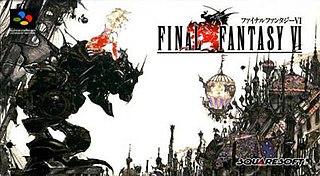
Final Fantasy VI, also known as Final Fantasy III from its initial North American release, is a 1994 role-playing video game developed and published by Square for the Super Nintendo Entertainment System. It is the sixth main entry in the Final Fantasy series, the final to feature 2D sprite based graphics, and the first to be directed by someone other than series creator Hironobu Sakaguchi; the role was instead filled by Yoshinori Kitase and Hiroyuki Ito. Long-time collaborator Yoshitaka Amano returned as character designer and concept artist, while composer Nobuo Uematsu returned to compose the game's score, which has been released on several soundtrack albums.
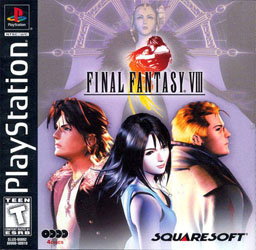
Final Fantasy VIII is a 1999 role-playing video game developed and published by Square for the PlayStation console. It is the eighth main installment in the Final Fantasy series. Set on an unnamed fantasy world with science fiction elements, the game follows a group of young mercenaries, led by Squall Leonhart, as they are drawn into a conflict sparked by a sorceress named Edea Kramer who seized control of a powerful military state. During the quest to defeat the sorceress and the forces manipulating her, Squall struggles with his role as leader and develops a romance with one of his comrades, Rinoa Heartilly.
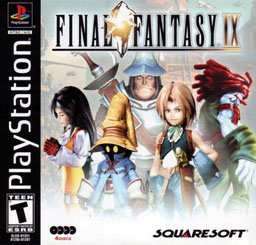
Final Fantasy IX is a 2000 role-playing video game developed and published by Square for the PlayStation video game console. It is the ninth game in the main Final Fantasy series. The plot focuses on a war between nations in a medieval fantasy world called Gaia. Players follow a thief named Zidane Tribal who kidnaps princess Garnet Til Alexandros XVII as part of a ploy by the neighboring nation of Lindblum. He joins Garnet and a growing cast of characters on a quest to take down her mother, Queen Brahne of Alexandria, who started the war.

Final Fantasy X is a role-playing video game developed and published by Square as the tenth main entry in the Final Fantasy series. Originally released in 2001 for PlayStation 2, the game was re-released as Final Fantasy X/X-2 HD Remaster for PlayStation 3 and PlayStation Vita in 2013, for PlayStation 4 in 2015, Windows in 2016, and for Nintendo Switch and Xbox One in 2019. The game marks the Final Fantasy series transition from entirely pre-rendered backdrops to fully three-dimensional areas, and is also the first in the series to feature voice acting. Final Fantasy X replaces the Active Time Battle (ATB) system with the "Conditional Turn-Based Battle" (CTB) system, and uses a new leveling system called the "Sphere Grid".

Final Fantasy V is a fantasy role-playing video game developed and published by Square in 1992. It is the fifth main installment of the Final Fantasy series. The game first appeared only in Japan on Nintendo's Super Famicom. It has been ported with minor differences to Sony's PlayStation and Nintendo's Game Boy Advance. An original video animation produced in 1994 called Final Fantasy: Legend of the Crystals serves as a sequel to the events depicted in the game. It was released for the PlayStation Network on April 6, 2011, in Japan. An enhanced port of the game, with new high-resolution graphics and a touch-based interface, was released for iPhone and iPad on March 28, 2013, for Android on September 25 the same year and for Windows on September 24, 2015. A more enhanced re-release of the game as part of the Final Fantasy Pixel Remaster series, was released on November 10, 2021 for Android, iOS, and Windows, and for Nintendo Switch and PlayStation 4 on April 19, 2023.
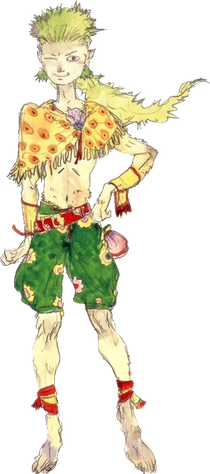
Gau is a character introduced in the 1994 role-playing video game Final Fantasy VI by Square Enix. A feral child, Gau was raised by animals in the game's Veldt location after his father abandoned him as an infant, and later develops a familial bond with the characters Cyan and Sabin after they offer him food. Unlike other characters in the game, he fights specifically using enemy movesets the player can learn through using him against enemy encounters on the Veldt, though this renders him unable to be controlled for the duration of the fight. He has since appeared in other games related to the Final Fantasy franchise, including Dissidia Final Fantasy Opera Omnia, where he is voiced by Tomo Muranaka.

Celes Chere is a character and protagonist in the video game Final Fantasy VI. She was created by Yoshinori Kitase and was his favorite character in the game. She struggles with allegiances between the Empire and the rebel group, the Returners before ultimately siding with the latter. She appears in other Final Fantasy titles, including the Theatrhythm series and World of Final Fantasy.

Setzer Gabbiani is a character introduced in the 1994 role-playing video game Final Fantasy VI by Square Enix. A gambler with an airship casino, he originally plots to kidnap the starlet of an opera, before he is coerced into joining the protagonists in their quest to stop the game's Gestahlian Empire. Created by Tetsuya Nomura, he was based on a character class he had originally planned for the game's preceding title, Final Fantasy V. He has since appeared in other titles related to the Final Fantasy franchise, including Kingdom Hearts II, where he is voiced by Crispin Freeman in English, and Ryōtarō Okiayu in Japanese.

Kefka Palazzo is a video game character and the main antagonist in the 1994 Square role-playing video game Final Fantasy VI. Yoshitaka Amano created his visual design and director Yoshinori Kitase wrote his scenes. He is one of the most well-known and well-received villains in the Final Fantasy series. His popularity led to featured roles in the fighting game Dissidia Final Fantasy and its sequels. He also appears as an enemy boss character in games including Theatrhythm Final Fantasy, Final Fantasy Artniks, Final Fantasy XIV: Stormblood, and Final Fantasy All the Bravest.
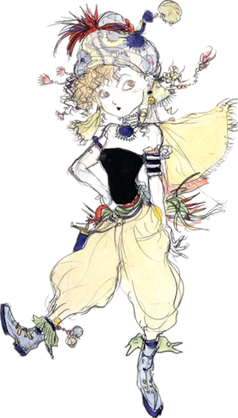
Relm Arrowny is a character in the 1994 video game Final Fantasy VI. She is one of the last characters recruited into the main party, and is often accompanied by her grandfather, Strago Magus. Her mother died when she was young, and her father later left her. Despite her father, Shadow, eventually reuniting with her, she never learns his true identity. She was designed by various people; Yoshitaka Amano, Tetsuya Nomura, and Kazuko Shibuya all do art for her, while Akiyoshi Ota and other writers devised her backstory.

Garnet Til Alexandros XVII, alias Dagger, is a character in the Final Fantasy series and one of the main cast of Final Fantasy IX. She is the princess of the kingdom of Alexandria and one of the lead characters. In this game, she is trying to escape her kingdom and joins with her kidnappers, including protagonist Zidane Tribal, to do so. She assumes the pseudonym Dagger and cuts her hair, at which point the writers began to treat her as a different character while writing her. In time, she discovers herself adopted, having come from a village of summoners.
Final Fantasy VII is a role-playing video game by Square as the seventh installment in the Final Fantasy series. Released in 1997, the game sparked the release of a collection of media centered on the game entitled the Compilation of Final Fantasy VII. The music of the Final Fantasy VII series includes not only the soundtrack to the original game and its associated albums, but also the soundtracks and music albums released for the other titles in the collection. The first album produced was Final Fantasy VII Original Soundtrack, a compilation of all the music in the game. It was released as a soundtrack album on four CDs by DigiCube in 1997. A selection of tracks from the album was released in the single-disc Reunion Tracks by DigiCube the same year. Piano Collections Final Fantasy VII, an album featuring piano arrangements of pieces from the soundtrack, was released in 2003 by DigiCube, and Square Enix began reprinting all three albums in 2004. To date, these are the only released albums based on the original game's soundtrack, and were solely composed by regular series composer Nobuo Uematsu; his role for the majority of subsequent albums has been filled by Masashi Hamauzu and Takeharu Ishimoto.
The music of the video game Final Fantasy VI was composed by regular series composer Nobuo Uematsu. The Final Fantasy VI Original Sound Version, a compilation of all the music in the game, was released in Japan by NTT Publishing in 1994 and re-released by Square Enix in 2004. The album was released by Square Co./NTT Publishing in North America in 1994 under the name Kefka's Domain. Selected tracks from the official soundtrack were later released as part of the Music From FFV and FFVI Video Games album that was included with the release of Final Fantasy Anthology, and two EPs were produced containing character theme tracks entitled Final Fantasy VI Stars Vol. 1 and Vol. 2. A special orchestral arrangement of selected tracks from the game, arranged by Shiro Sagisu and Tsuneyoshi Saito, and performed by the Milan Symphony Orchestra, was released under the title Final Fantasy VI Grand Finale by NTT Publishing in 1994 and 2004, and a collection of piano arrangements, arranged by Shirou Satou and performed by Reiko Nomura, was released under the title Piano Collections Final Fantasy VI by Square/NTT Publishing in 1994 and by NTT Publishing in 2001. Additionally, a single containing unused and remixed tracks from the game was released as Final Fantasy VI Special Tracks by NTT Publishing in 1994.
Square's role-playing video game Final Fantasy VI, which was released as Final Fantasy III in North America, features fourteen permanent player characters, the largest number of any game in the main Final Fantasy series, as well as several characters who are briefly controlled by the player.
The music of the video games Final Fantasy and Final Fantasy II was composed by regular series composer Nobuo Uematsu, who would go on to be the exclusive composer for the next eight Final Fantasy games. Although they were composed separately, music from the two games has only been released together. All Sounds of Final Fantasy I•II, a compilation of almost all of the music in the games, was released by DataM/Polystar in 1989, and subsequently re-released by NTT Publishing in 1994. Symphonic Suite Final Fantasy, an arranged album of music from the two games by Katsuhisa Hattori and his son Takayuki Hattori was released by DataM in 1989, and re-released by NTT Publishing/Polystar in 1994. Final Fantasy & Final Fantasy II Original Soundtrack, another arranged album, this time by Nobuo Uematsu and Tsuyoshi Sekito, was released in 2002 by DigiCube and again in 2004 by Square Enix.
The music of the video game Final Fantasy IV was composed by regular series composer Nobuo Uematsu. The Final Fantasy IV Original Sound Version, a compilation of almost all of the music in the game, was released by Square Co./NTT Publishing, and subsequently re-released by NTT Publishing. It was released in North America by Tokyopop as Final Fantasy IV Official Soundtrack: Music from Final Fantasy Chronicles, with one additional track. It has since been re-released multiple times with slight changes as part of the Final Fantasy Finest Box and as Final Fantasy IV DS OST. An arranged album entitled Final Fantasy IV Celtic Moon, containing a selection of musical tracks from the game performed in the style of Celtic music by Máire Breatnach, was released by Square and later re-released by NTT Publishing. Additionally, a collection of piano arrangements composed by Nobuo Uematsu and played by Toshiyuki Mori titled Piano Collections Final Fantasy IV was released by NTT Publishing.
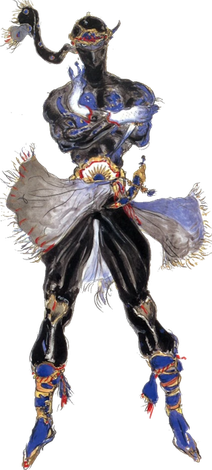
Shadow is a character introduced in the 1994 role-playing video game Final Fantasy VI by Square Enix. He was conceived by Tetsuya Nomura, based on a character class idea he had wanted to utilize in Final Fantasy V. A ninja mercenary, he travels with a canine companion, Interceptor, and is available during certain sections of the game as a party member. Elements of his past may also be revealed to the player, in which they discover he was originally a robber named Clyde, who after the death of his partner in crime abandoned eventually abandoned his past and took on the name Shadow. He has since appeared in other games related to the Final Fantasy franchise, including Dissidia Final Fantasy Opera Omnia, where he is voiced by Yoshito Yasuhara.

Granblue Fantasy is a Japanese role-playing video game developed by Cygames for Android, iOS and web browsers, which first released in Japan in March 2014. The game reunites music composer Nobuo Uematsu and art director Hideo Minaba, who previously collaborated on Final Fantasy V (1992), VI (1994), and IX (2000) and Lost Odyssey (2007).

Final Fantasy X/X-2 HD Remaster is a high-definition remaster of the role-playing video games Final Fantasy X (2001) and Final Fantasy X-2 (2003), originally developed by Square on the PlayStation 2 in the early 2000s. It also features story content previously only found in the International versions, and a new audio drama set a year after the events of X-2. The collection saw graphical and musical revisions and is based on the international versions of both games, making certain content accessible to players outside of Japan for the first time.

Edgar Roni Figaro and Sabin Rene Figaro are two characters in the 1994 video game Final Fantasy VI. They are main characters who become allied with characters like Terra Branford and Celes Chere while they battle the Gestahlian Empire and Kefka Palazzo. Edgar is the king of Figaro Castle while Sabin trains in the mountains, a deal they arrived at after Edgar rigged a coin flip in Sabin's favor so he would not have to be king. They are both later separated from the others after the end of the world, though they can be reacquired over the course of the second half of the game. They were created by Soraya Saga, who was responsible for their backstory and dialogue.















